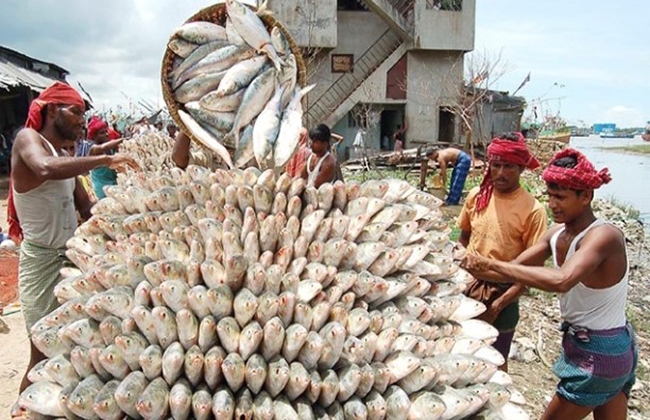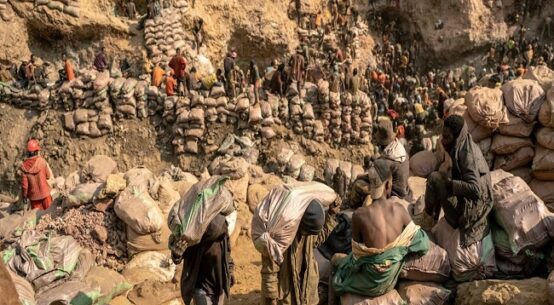
It may look like a nondescript silvery fish, but hilsa, or Tenualosa ilisha, accounts for an eighth of Bangladesh’s total fish catch, and more than one percent of the country’s economic output. It’s so important that the government bans hilsa fishing twice a year, for about three weeks at a time, to allow the fish to breed and to protect the juveniles.
The latest ban ended on Oct. 28, and while the government was supposed to hand out compensation packages to fishers during this period, many say they still haven’t received it.
Mongabay spoke with fishers in coastal districts including Bhola, Patuakhali, Lakhimpur and Barisal. One of them was Abdul Jalil Sikder, from Bhola, one of the main hilsa-yielding spots in Bangladesh. He said the district administration had promised fishers 40 kilograms (88 pounds) of rice through the local union council in exchange for not fishing during the 22-day ban.
“But we did not get any,” Sikder said, adding that the government’s attitude toward fishers has been unfair. Local media have reported that several fishers have been hit with fines and even jail time for violating the ban.
“If the government wants us not to fish during this time, we need to receive the compensation on time, otherwise we must venture for the fishing to meet our needs,” Sikder said. “Fear of fine or jail will not work as this is our livelihood.”
To aid in the distribution of the compensation packages, the government launched a “fisherman’s card” at the start of the ban. Recipients can then use the cards to claim the packages. But fisherman Rezaul Karim, also from Bhola, said that in many cases, actual fishermen didn’t receive the cards. They went instead to family members and cronies of powerful local officials, he said.
“For the poor fishermen who live hand to mouth, it is tough to go out of work for a day even,” said M. Mukhlesur Rahman, executive director of the Center for Natural Resources Study (CNRS) , a nonprofit. “The package that the government is providing is negligible.”
Zia Haider Chowdhury, head of the government’s hilsa conservation program, acknowledged that some fishers still hadn’t received the promised compensation even as the ban period winds down. “We are trying to reach the compensation to the fisherfolks on time. Though is it uncommon, sometimes we fail to do so due to the remoteness of coastal areas.”
He also said the government has been increasing the amount of compensation gradually.
According to official data, almost 500,000 fishers across Bangladesh are directly involved in the hilsa industry, and another 2 million are indirectly involved.
The government introduced periodic bans on hilsa fishing in the early 2000s. The current ban that ends on Oct. 28 is for protecting the spawn, and has been enforced every October since 2007.
Anisur Rahman, chief scientific officer of the state-funded Bangladesh Fisheries Research Institute, said that if the government wants to get the best results from the ban, it has to ensure that the fishermen receive their compensation properly. The issue relates to their livelihoods, he pointed out, so they have to be given an alternative during the no-catch periods.
The government has been doing this in recent years, introducing alternative livelihoods for fishers under the Hilsa Conservation Trust Fund (HCTF). Rahman, who is involved in the process, said he believes the trust fund will help to ensure viable livelihood options for the fishers during the bans.
Hilsa: A national treasure
Bangladesh produced 565,183 metric tons of hilsa for the 12-month period ending June 2021, according to the latest Yearbook of Fisheries Statistics. Nearly two-thirds was caught in the sea, and the rest from rivers. The hilsa catch accounts for around 12% of Bangladesh’s total fish production, the report says.
Due to high demand both at home and abroad, overfishing of hilsa in the recent decades has led to concerns over the sustainability of the fishery. This in turn prompted measures from the government that include the periodic fishing bans.
Hilsa sanctuaries in Bangladesh
- 100-kilometer (60-mile) stretch of the Meghna River between Shatnol and Char Alexander
- 90-km (56-mi) stretch of the Shahbazpur Channel in the Meghna estuary, Bhola district
- 100-km stretch of the Tentulia River, Bhola district
- 40-km (25-mi) stretch of the Andharmanik River, Patuakhali district
- 20-km (12-mi) stretch of the lower Padma River (Padma confluence), Shariatpur district
- 83-km (52-mi) stretch of the Meghna River between Hizla and Mehendiganj, in Barisal district
(This article is republished from Mongabay under Creative Commons License)
Abu Siddique is Mongabay’s Contributing Editor for Bangladesh. He has worked for several of the leading national dailies including Dhaka Tribune, Daily Sun and The Business Standard, and has explored the remotest corners of the country in search of stories.


